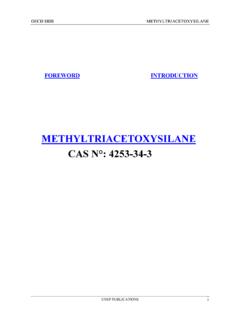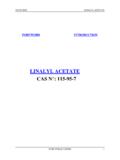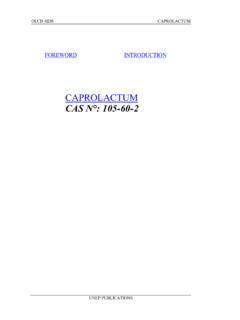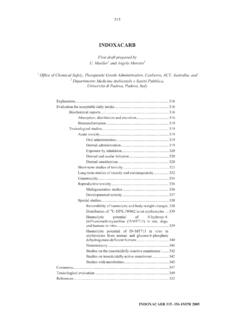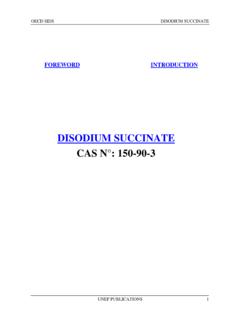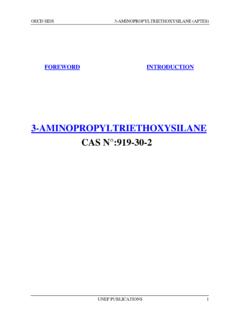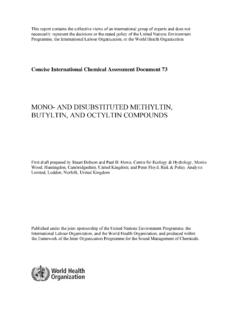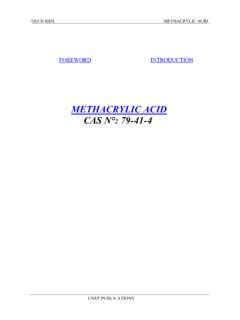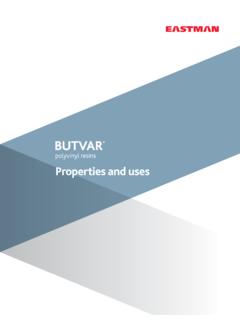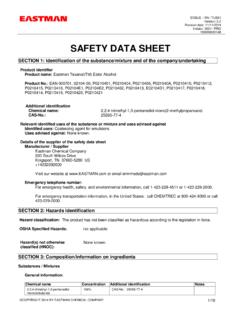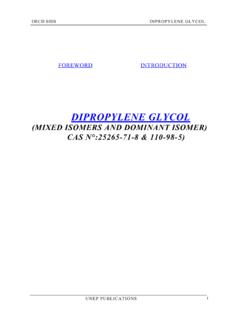Transcription of TEXANOL CAS N°: 25265-77-4 - INCHEM
1 OECD SIDSTEXANOLUNEP PUBLICATIONSFOREWORDINTRODUCTIONTEXANOLC AS N : 25265-77-4 Identifiers, Physical and Chemical properties73 CAS Number : 25265-77-4 End Point : IDENTIFIERS, PHYSICAL AND CHEMICAL PROPERTIESS ubstanceChemical Name : Propanoic acid, 2-methyl-, monoester with 2,2,4-trimethyl-1,3-pentanediolCommon Name : TexanolProperties & DefinitionsMolecular Formula : C12H24O3 Molecular Weight : Point : -50 CBoiling Point : 244 CState : LiquidFlash Point : 120C (o-cup)Flamable Limit : at 149C - at 201 CDensity : at 20 CVapour Pressure : mbar ( mmHg) at 20 COctanol/Water Partition : at 25C experimentalWater Solubility : 858 mg/L at 18-22C *Colour : ColourlessOdour : MildAdditives : No additive typically : 2,2,4-Trimethyl pentane-1,3-diol (CAS RN: 144-19-4); TXBI( TEXANOL isobutyrate) (CAS RN = 6846-50-0); NPGDI ; TMPI: trace; 3-isobutyroxy-2,2,4-trimethyl pentanol: trace.
2 3-oxo-2,2,4-trimethyl penten-1-ol: trace; keto ester: Comments :VP = mbar ( mmHg) at 25C is also reported.*In distilled water; 519 mg/L in diluent water at 18-22C. Vapor density : (air=1); auto ignition temperature 393C. Material is unlikely to accumulate a static charge which could act as an ignition source. Stable; can react with strong oxidizing agents. Polymerizaiton will not CS 12CS 12 Isobutyraldehyde tishchenko trimerIsobutyric acid, ester with 2,2,4-trimethyl-1,3-pentanediolTexanol ester alcohol2,2,4-Trimethyl-1,3-pentanediol monoisobutyrateSynonymslog Pow = EXPOSUREENVIRONMENTAL EXPOSUREB ased on its physiochemical properties , the test material will not be a persistent environmental contaminant.
3 With the exception of an unlikely spill situation (99% of the material is handled in closed tanks and drums; formulation of latex paints, which accounts for 84% of the total use and over 97% use of the non-intermediate use of the material is conducted in closed equipment), the only environmental exposure will be via the air during the drying of paint. The low vapor pressure ( mbar at 20C) and high boiling point (244C) of the material would preclude high localized airborne concentrations of the test material. Estimated atmospheric residence time for the test material is 403 hours, which predicts ultimate degradation of the test material in EXPOSUREThe primary exposure to this substance is during its end use in latex paint, during application and subsequent drying of thepaint In order to characterize worker and consumer exposure to this material a study wasOverall EvaluationIRPTC Data Profile Identifiers.
4 Physical and Chemical properties74conducted in which airborne concentrations of the substance were measured in a study conducted to characterize worker and consumer exposure to volatile components during field application and subsequent drying of water based polyvinyl acetate paints. Paints were applied using airless spraying of roller/brush methods in rooms having either or air changes per hour. For each scenario, a personal breathing zone air sample was collected during application, and fixed station air samples were collected during application and 6 hours, 24 hours, and one week after application. The maximal concentration of the substance from breathing zone samples was ppm (during spraying applications) with a room air exchange rate of 5 air changes per hour.
5 At an exchange rate of air changes per hour, the maximum concentration measured from fixed stations during roller applications was ppm. Overall average concentrations measured in rooms with an exchange rate of air changes per hour was only ppm. The average concentration during spray application in a room with air changes per hour was ppm, and the corresponding average for roller applications was ppm. Six hours after application, concentrations of the chemical were below the ppm average environmental limit of detection in the rooms with an air exchange rate of air exchanges per hour. At 24 hours, levels were below the limit level of detection of ppm in 19 of 24 rooms (combined rooms having either or air changes per hour).
6 Only one of four samples collected at 7 days contained the chemical at a concentration above the ppm limit of EXPOSUREIn manufacture, dry, acid-free isobutyraldehyde is self-condensed in the presence of trace sodium isobutoxide catalyst in an enclosed, continuous manufacturing system. The product mixture is water-washed to remove the sodium salts, and then passes through distillation columns to remove the product from other substances also formed from the chemical reaction. The refined product typically assay or higher. The process water is treated to remove essentially all remaining traces of product. The manufacturing process has various vents which release insignificant amounts of the product because of its low volatility.
7 There are two process waste streams containing small amount of the product. These streams are manufacture, fifteen one-liter samples are taken each day (347 days per year) for analysis. Thirty minutes are required to take and analyze each sample. This operation is rotated among 40 different workers per year. Some dermal exposure is possible (from spilling), but it would be slight and infrequent. During equipment maintenance, the equipment is drained free of material. Mechanics wear protective goggles and impermeable gloves; thus, dermal exposure is negligible. Some inhalation exposure may occur during drumming and loading tank cars (15 minute operations), but inhalation exposure is not appreciable, since the substance has a low vapor pressure and good ventilation is provided to the work area.
8 Industrial hygiene monitoring of the work area indicates that the 8-hour time-weighed average air concentration of the substance is typically less than processing to make plasticizer, the substance is normally stored in tanks and transported through closed lines to continuous reactors for chemical conversion. A small number of workers could be exposed for a few minutes when taking small quality control samples prior to chemical conversion. The low vapor pressure of the material minimizes the level of exposure during exposure occurs routinely during handling of the material, since it is primarily (99%) stored in closed tanks and in closed drums.
9 Transport is predominantly in tank cars and tank AND CONCLUSIONSThe potential occupational exposure is low because the substance is manufactured and processed in closed continuous equipment. Inhalation exposure is further limited by the low vapor pressure of the substance. Dermal exposure could occure infrequently by accident or during quality control sampling; however, it is the practice to wear impermeable gloves and other protective clothing at points of potential exposure is likely, since the predominant use of this substance is as a coalescing aid at up to 3% concentration in latex paints. Although the number of consumers potentially exposed is high, the level of exposure is low (average room concentration of ppm during roller application of latex paint in a room with room air changes per hour) during the few days per year the average consumer spends exposure occurs primarily through volatilization of the substance from drying latex paint.
10 Terrestrial and aquatic exposure would occur rarely through spills. The substance is predicted to undergo photodecomposition slowly in the atmosphere, and does not persist elsewhere in the environment, because it biodegrades at a modest results of the SIDS testing indicate that the substance has a relatively low order of toxicity. Because of this low level of toxicity, low level of human exposure, and lack of persistence in the environment, it is recommended that a low priority be assigned to this substance for further Data Profile Production-Trade75 CAS Number : 25265-77-4 Production-TradeGeographic Area : USAC hemical Name : Texanol1989 Production44359 t - P25000-50000 t/y - PQuantityYearGeneral Comments : 25000 - 50000 tonnes/year (1977 TSCA Inventory).
